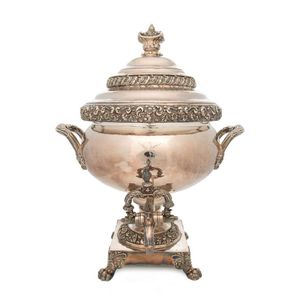George IV Silver Soup Tureen with Elaborate Acanthus Motifs
A George IV sterling silver soup tureen and cover, Richard Sibley, London 1822 the tureen of oval form with a gadrooned rim and elaborate acanthus and shell motifs to the handles, raised on four paw feet, the domed cover with applied chasing, gadrooned and shell border with foliate reeded handles 4720gms, 28 cm high, 46 cm wide
You must be a subscriber, and be logged in to view price and dealer details.
Subscribe Now to view actual auction price for this item
When you subscribe, you have the option of setting the currency in which to display prices to $Au, $US, $NZ or Stg.
This item has been sold, and the description, image and price are for reference purposes only.
- Foliate - Decorated with leaves or leaf-like forms.
- George Iv - George IV (1762 ? 1830) was king of the United Kingdom of Great Britain and Ireland and king of Hanover from 1820, until his own death in 1830. From 1811 until his accession in 1820, he served as Prince Regent during his father's final mental illness.
In English furniture design, his reign from 1811 to 1830 is known as the Regency period. - Gadrooning - A series of lobes usually as a border. In furniture gadrooning is found as carved decoration around the edges of table tops in the Chippendale and Jacobean style furniture. Gadrooning is also found as decoration on the rims of silver and ceramics.
- Scallop / Shell Motif - The shell motif has been used in furniture and decorative arts for centuries. In ancient Greece and Rome, shells were often used as decorative elements on furniture and in mosaics. The scallop or cockleshell are the most commonly used. During the Renaissance, the shell motif became popular in furniture and architecture, as the ornate decoration was seen as a symbol of wealth and luxury. In the 18th century, the Rococo style of furniture and decorative arts featured an abundance of shell motifs, and it was used by Thomas Chippendale and as a feature on Queen Anne style cabriole legs. In the 19th century, the shell motif was incorporated into Victorian furniture and decorative items, and often a representation of the the conch shell was inlaid into furniture.
- Tureen - Circular or oval, deep, covered bowl, used from the early 18th century for serving soup, sauce, vegetables or stew. As well as silver, tureens are also made in porcelain, pottery, and silver plate, Sauce tureens are smaller, plainer versions. The name derives from the French "terrine", meaning 'earthen vessel',
- Acanthus - A stylized leaf motif, one of the primary decorative elements of classical Greek and Roman architecture, derived from the genus of flowering plants in the family Acanthaceae, native to tropical and subtropical regions of the Mediterranean area. It is a common element in classical Greek and Roman design, and is often seen in Corinthian and Composite order columns and used as a decorative element in English, European and Australian furniture, particularly on the curve of a leg, and as decoration for a corbel.
- Sterling Silver - Sterling silver is a mixture of 92.5% pure silver and 7.5% of another metal, usually copper. Fine silver is 99.9% pure silver, and is relatively soft and the addition of the very small amount of copper gives the metal enough strength and hardness to be worked into jewellery, decorative and household objects.
- Chasing - The method of decorating gold and silver objects using a punch and hammer so that the design appears in relief. Flat or surface chasing is done from the front giving the item definition, but not cutting into the metal.
Chasing is the opposite technique to repousse, but an object that has repousse work, may then have chasing applied to create a finished piece.
This item has been included into following indexes:
Visually similar items

A Victorian silver plated samovar, with central armorial crest, English, 19th century. 46 cm high
Sold by
in
for
You can display prices in $Au, $US, $NZ or Stg.

Pair of impressive silver plate three piece entree dishes (2)
Sold by
in
for
You can display prices in $Au, $US, $NZ or Stg.

French polished pewter tureen, 21 cm high, 30 cm long
Sold by
in
for
You can display prices in $Au, $US, $NZ or Stg.

Royal Worcester twin handle signed lidded urn with handpainted fruit and gilt decoration, signed Telford, height 28.5 cm
Sold by
in
for
You can display prices in $Au, $US, $NZ or Stg.
